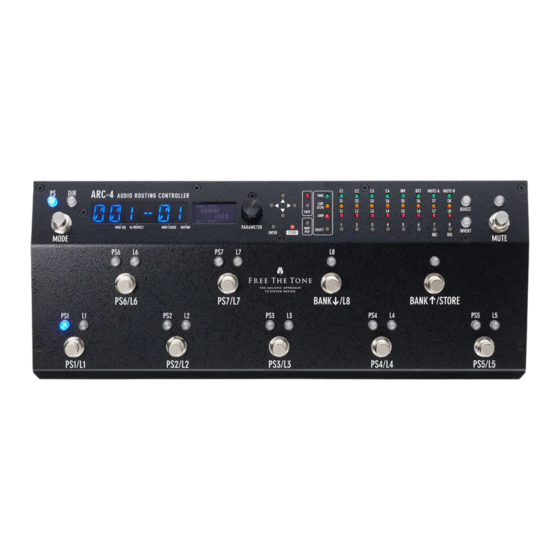Free The Tone ARC-4 Panduan Pemilik - Halaman 4
Jelajahi secara online atau unduh pdf Panduan Pemilik untuk Peralatan Perekaman Free The Tone ARC-4. Free The Tone ARC-4 16 halaman. Audio routing controller
Juga untuk Free The Tone ARC-4: Prosedur Pembaruan Firmware (18 halaman)

Controls and Indicators
Rear Panel
HTS-IN Terminal
HTS-OUT Terminal
Connect your guitar/bass,
Output terminal that sends the signal fed to the HTS-
etc. to this terminal. When
IN terminal to another signal line. Bassists can use
a guitar/bass is connected
this terminal as a line to feed a D.I. box. This signal
to the HTS-IN terminal, the
line can be interlocked with the MUTE switch.
HTS input circuit optimizes
Using ARC-4 Efficiently p.25
Selecting Mute Circuit to be Activated when MUTE
its signal and sends it to
Switch is Turned On p.22
an effects unit or amplifier
connected to the ARC-4.
TUNER Terminal
Used to connect to an external tuner.
The signal fed to the HTS-IN or IN
terminal appears at this terminal
even when the MUTE switch is turned
on.
S-1–5, R-1–5 Terminals (Monaural)
Effect loop terminals.
The S-1–S-5 terminals send signals to
the connected effects unit and the R-1–
R-5 terminals receive the signals that went
through the effects unit.
S-INS-R Terminals (Insert Terminal)
The INS-S terminal is an output terminal that feeds signals that went
through from the effect loops 1 to 5. This output will not be muted even
when the MUTE switch is turned on.
RETURN
The INS-R terminal is an input terminal located just before the effect loop 6.
The S-INS-R terminals are internally connected unless a plug is connected
to either of them.
S-6/A·B–S-7/A·B, R-6/A·B–R-7/A·B Terminals (Stereo)
SEND
Stereo effect loop terminals.
Signals are sent from the S-6/A, S-6/B – S-7/A, and S-7/B terminals to the
connected effects units. Signals that went through the effects unit are
received at the R-6/A, R-6/B – R-7/A, and R-7/B terminals.
Terminals in Detail p.8
6
IN Terminal
Input terminal located just after the HTS input circuit.
Connect your guitar/bass, etc. to this terminal if you
do not want to let its signal go through the HTS input
circuit.
Using ARC-4 Efficiently p.25
IN-8, S-8 (N.C), R-8, OUT-8 (N.O) Terminals (Separate Loop)
Effect loop terminal electrically isolated from other loops. Signals are sent
to the connected effects unit from the S-8 terminal. Signals that went
through the effects unit are received at the R-8 terminal.
Terminals in Detail p.8
Using ARC-4 Efficiently p.25
STEREO/PARA Switch
Press this switch to select either
Stereo or Parallel Output mode.
STEREO Mode p.9
PARA Mode p.9
OUT-A Terminal
This terminal outputs signals that
go through from the effect loops 1
to 7.
Signals are always being output
irrespective of the STEREO/PARA
switch selection.
Terminals in Detail p.8
Signal Flow p.9
Using ARC-4 Efficiently p.25
OPTION-1 (EFS-3) Terminal
C1–C4 Terminals
The function assigned to this terminal can be
Control terminals that can operate in Latch or Momentary mode and are used to control amplifier channel
activated from the EXTERNAL FOOTSWITCH/EFS-3
switching, reverb on/off, etc. External control devices can be connected to these terminals by using standard
(option) connected to the ARC-4 using the dedicated
stereo plugs (TRS).
link cable.
Terminals in Detail p.8
C1/C3/
C2/C3/
OPTION-2 (PHA-1) Terminal
C4
C4
The function assigned to this terminal can be
activated from the PHASE ANALYZER/PHA-1 (option)
connected to the ARC-4 using the dedicated link
cable.
Terminals in Detail p.8
STEREO PHONE
N.B. If you use a standard monaural plug cable to connect the device, you can use C1, C3, and C4 only.
BOOST-B Knob
BOOST-A Knob
Adjusts the boost level at the OUT-B
terminal when the Boost function
Adjusts the boost level at the
OUT-A terminal when the Boost
is activated and the STEREO/PARA
function is activated.
switch is set to STEREO mode.
Terminals in Detail p.8
Terminals in Detail p.8
OUT-B Terminal
This terminal outputs signals that go through from the effect loops 1 to 7.
The flow of output signals changes according to the selection by the STEREO/
PARA switch.
Terminals in Detail p.8
Signal Flow p.9
Using ARC-4 Efficiently p.25
C1 terminal: When C1 is turned on, the tip and ground of the plug are
Tip : Hot
electrically connected.
Ring : Cold
C2 terminal: When C2 is turned on, the ring and ground of the plug are
electrically connected.
Sleeve : GND
C3 terminal: When C3 is turned on, the tip and ground of the plug
are electrically connected but the ring and ground of the
plug are disconnected. When C3 is turned off, the tip and
ground of the plug are disconnected: the ring and ground
of the plug are electrically connected.
C4 terminal: When C4 is turned on, the tip and ground of the plug
are electrically connected but the ring and ground of the
PLUG
plug are disconnected. When C4 is turned off, the tip and
ground of the plug are disconnected: the ring and ground
of the plug are electrically connected.
E4 (EXP) Terminal
An external footswitch or expression pedal
is connected to this terminal.
Terminals in Detail p.8
POWER DC12V IN Receptacle
Used to connect the
dedicated AC adapter.
When the connected AC
adapter is plugged in an
AC outlet, the ARC-4 is
powered on.
N.B. Be sure to use the
AC adapter supplied
with your ARC-4.
LINK Terminal
Used to connect to another ARC-4 for linked operation. Use
a dedicated link cable RC-5X (option). For more detailed
information on this dedicated cable please contact your local
dealer or Free The Tone directly.
MIDI IN and OUT/THRU Terminals
These terminals are used to send/receive MIDI signals to/from the connected
external MIDI device.
MIDI OUT/THRU setting is switched in Edit mode.
Setting MIDI OUT/THRU Terminal p.18
7
